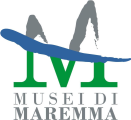Taste through the centuries. The ‘Etruria at the Table’ exhibition in Orbetello
From the history of the cup, the ‘kylix’ developed in Greece and adopted first by the Etruscans and then by the Romans, to the Etruscan banquet and the banquet that the Romans put on the table from its origins to beyond the Republican age. We are talking about food and antiquity, a fascinating story that spans the centuries told by the exhibition ‘L’Etruria a Tavola. At the Origins of Taste in Ancient Tuscany’ on display from 28 July to 10 November in the Polveriera Guzman, Orbetello Archaeological Museum. An exhibition project realised thanks to the selection of the rich materials already present in the collection of the Orbetello museum, now equipped with a new thematic didactic apparatus perfect for more or less expert audiences.
By means of information panels and selected archaeological artefacts displayed in various sections, visitors are guided to the discovery of lost flavours such as the cereal and milk gruel called puls, the famous fish sauce called garum or the dormouse meat stew, considered a true delicacy by the Romans.
The evolution of taste, caused by cultural, commercial and economic factors, also led to changes in tableware: this is confirmed by the evolution of design over the centuries of cups, glasses, bowls and plates from the 7th century B.C. until the 2nd century A.D. And that’s not all: at the end of the museum experience, visitors will be able to take home a small recipe book to recreate an Etruscan and Roman menu on their own tables!
‘The artefacts in the Museo Archeologico Polveriera Guzman,’ explains the accompanying text to the exhibition, ’take us on a journey back in time to discover the recipes and tables of our ancestors, from the Etruscan age to the Roman world, when trade permitted the arrival of countless raw materials from all over the known world: apricots from China, but arrived in Rome via Armenia and therefore called ‘armeniaca’, lemons, citrons and peaches from Persia, dates and pineapples from Africa and spices from the East. At the same time, food and the way food was consumed also changed, a transformation reflecting social changes over the centuries. Knowledge about food in the ancient world is vast and diverse: artistic and literary sources from ancient Greek and Roman authors, archaeological evidence, and the remains of ancient plants and animals found in excavations tell us about it’.
The exhibition, organised by the Cooperativa Sociale Zoe in cooperation with the Municipality of Orbetello and the consultancy of the University of Siena, is free and open every weekend and holidays from 6pm to 11pm for the month of August. From 1 to 30 September it will be open on Saturdays from 4 to 8 p.m., Sundays and holidays from 9 a.m. to 1 p.m. and from 4 to 8 p.m. From 1 October to 31 December 2024 on Saturdays from 2.30 to 5.30 p.m., Sundays and holidays from 10 a.m. to 1 p.m. The Museum is located in Via Mura di Levante, 5, in Orbetello (Gr). Info, tel. +39 3505905073, e-mail: museoguzman@comune.orbetello.gr.it







